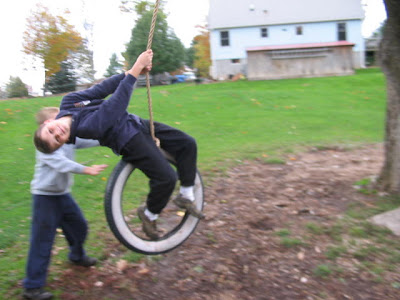Well actually I cannot say that I am at a complete loss, because I remember doing this myself when I was young. Piles of objects in cans or on tables were often an irresistable invitation to investigate thoroughly and separate each object carefully into sizes, shapes, colors, and functions. BUTTONS were an especially alluring treasure now that I remember them, and there was nothing more luxurious than plowing your fingers through each and every one and taking hours upon hours to sort the lot out.
The kids have been impassioned collectors of everything for as long as I can remember. Various choices that come to mind have included 'normal' things such as baseball cards, Pokemon cards, action figures, matchboxes, Legos, and series books, but some of the crazier things have also included walking sticks, dead bees, license plates, antique meat grinders, property line tape and markers, old VCRs, and wooden fisherman buoys, LOL.
I am pretty sure I know why they do it, or why any person must choose to hoard anything without a serious reason. Collecting and quantifying an object is an attempt to collect and quantify the world. Organizing something and putting it into a category is an incredibly sensible way of deriving meaning from a world that is complicated and confused, and it even helps exert a little bit of control over it. It is grounds for hysteria that the educational standard in New York puts such a heavy emphasis on 'teaching' kids to categorize objects, because no child has ever needed instruction to do something that is so innate and natural.
This Saturday we cut down a tree in the front yard. Once the guys with the chainsaws left, the kids moseyed on over to carefully survey the scene. After one or two moments of studied silence, Keith suddenly said "Quick. We need sawdust!" He ran into the house and took a ziploc storage bag out of the pantry, and banged out the front door again. In another minute he ran back in, grabbed a Sharpie from the jar by the phone and ran off yet again. A couple of minutes later he returned with a full plastic bag that was neatly labeled, 'Sawdust'.
Now the other guys got the idea, and decided that one bag of anything could not possibly be enough. They took the baggie box out the door and began to collect twigs and pieces of bark, separating them carefully and labeling them legibly. At this point, a full-fledged search began as the potential of this project was realized, and backpacks were dug out of closets, sandwiches packed, and markers, tools, bags, and compasses were thrown into the bag along with assorted, unrelated stuff. Each kid grabbed his favorite walking stick (bunched in a pile from an earlier collection), and set off into the woods towards the pond.
An hour (or maybe more) later, they came back home with this:

Included with what they found were cattails, leaves, fungus, milkweed, and an assortment of other objects, some of which were too big to fit into any old ziploc.
There was a bunch of----
and some carefully stored-----
And this, my absolute, ABSOLUTE favorite, a stroke of genius by any stretch of the imagination IMO! :-D
I don't have any idea what the kids will eventually do with any of this. I'm sure they don't either. The point of it, and the point of anything that children seem to do in my honest opinion, is that it is not the result that matters, but the process that gets us there. Things were learned this day that would have pleased and impressed an academic, but I am sure that their reasons had nothing to do with educational skill. A child without fear needs no reason to do anything, because learning is as natural as breathing. We could all do with taking lessons from collectors, especially the young ones:).

















